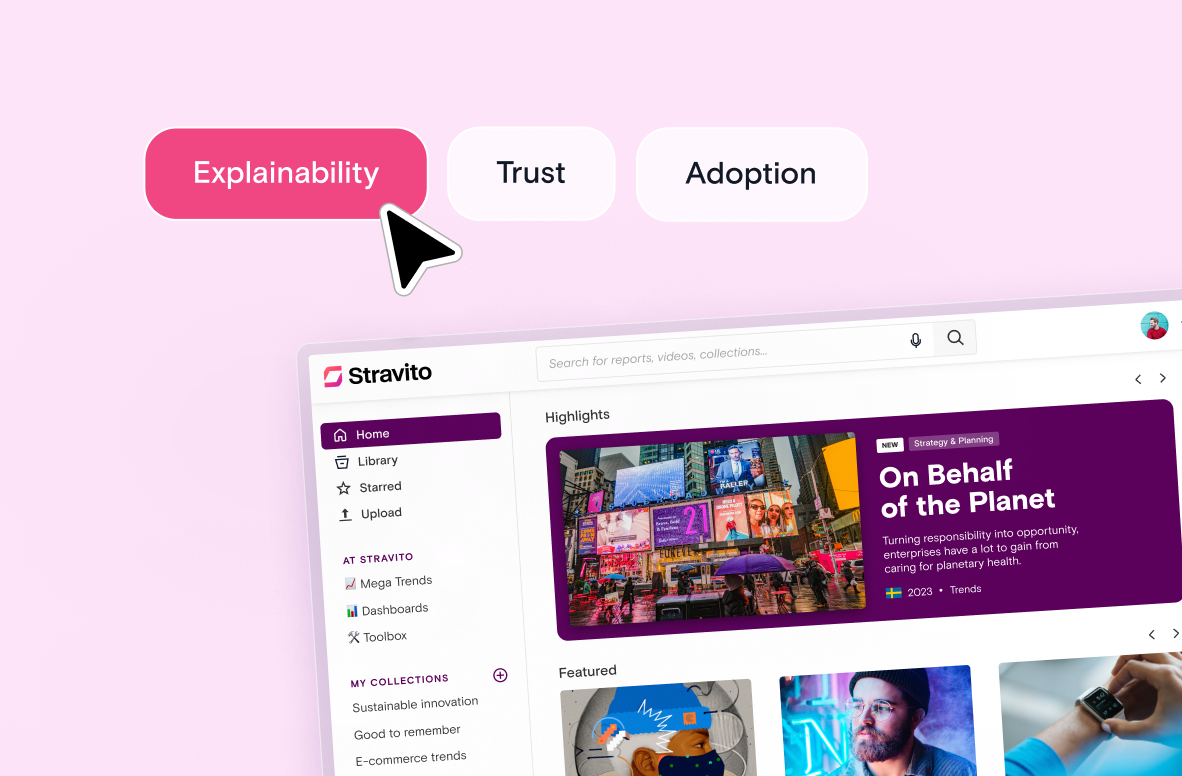In enterprise environments, there’s no shortage of knowledge. But is it being used?
Most companies track activity. Logins. Downloads. Uploads. But these usage metrics can’t tell you if your knowledge management efforts are driving better decisions. Without the right KPIs, insights risk becoming shelfware.
To measure what matters, you need to go beyond counting clicks and focus on how knowledge is shared, applied, and activated across the business.
We know you're busy, so here are the main takeaways:
- Traditional activity logs are not enough. Meaningful KPIs track engagement, content health, collaboration, and strategic value.
- Metrics like search-to-find ratio, insight activation rate, and content freshness show what’s working and what’s not.
- AI tools provide important knowledge management metrics by surfacing usage patterns, gaps, and new opportunities.
- Stravito makes it easy to track both behavior and business impact, without the manual overhead.
Let’s take a closer look at why meaningful knowledge management KPIs matter and how to choose the right ones for your team.
Knowledge management needs more than activity logs
Tracking logins and downloads might seem like a start, but they don’t reveal whether knowledge is making an actual impact.
If you want to measure the success of your knowledge management strategy, you need to shift your focus from activity to outcomes. That means looking beyond user behavior and usage metrics to understand how knowledge is being shared, reused, and applied.
This shift reflects the evolution of enterprise knowledge management. In the past, teams focused on building document libraries.
Today, the goal is to activate insights by making them accessible, relevant, and decision-ready.
So what’s the difference between general usage metrics and knowledge management KPIs?
- Usage metrics track basic actions, such as how many people logged in, how often they searched, or which documents were downloaded.
- Knowledge management KPIs track value: how often insights are reused, how much time is saved through centralization, or how many strategic decisions reference shared knowledge.
Understanding that difference is key to building a more effective knowledge management program.
To track real impact, you need the correct set of metrics. Let’s break down the key categories of knowledge management KPIs and what each one can tell you.
Categories of knowledge management KPIs
To get a complete picture of your knowledge management performance, it helps to group KPIs by what they measure. Here are four categories that matter most.
Engagement metrics
These show how often people interact with your knowledge management platform and how engaged they are once they log in. Think beyond raw traffic and focus on meaningful use.
- Login frequency
- Time spent per session
- Repeat visits
- Interactions per collection
These metrics can help identify user engagement trends and show which teams are actively using your knowledge resources.
Content health and relevance
Outdated knowledge clogs your system, slowing everyone down. These KPIs focus on how current, accessible, and valuable your content is.
- Percentage of updated versus stale content
- Search success rate
- Article feedback or satisfaction ratings
- Document view-to-conversion ratio
Healthy content means users can easily find what they need and trust the information they find.
Contribution and collaboration
Knowledge management isn’t just about consumption. These metrics show how often people contribute, curate, and collaborate.
- Percentage of users uploading or tagging content
- Number of new insights added each quarter
- Number of collections created or shared
These indicators reveal how well knowledge is being maintained and enriched across your organization.
Business activation and strategic value
This is where KPIs move beyond the platform and into business impact. These metrics show how insights influence decisions, projects, and performance.
- Time-to-insight for everyday use cases
- Number of insights referenced in strategic deliverables
- Percentage of briefs or initiatives that used the KM platform
- Stakeholder feedback
These are the KPIs that help you link your knowledge management initiatives to business outcomes.
Now that we’ve covered the categories, let’s look at a concrete list of KPIs you can start tracking right away.
Knowledge management KPIs to track
The best KPIs don’t just measure activity. They show how knowledge is used, reused, and turned into action.
Here is a list of key performance indicators for knowledge management that we think you should keep your eye on:
Category: Engagement metrics
1. Unique active users
Tracks how many individuals are actively engaging with the platform over time. A drop in active users could signal adoption issues.
Good to know: If 200 employees have platform access but only 38 logged in last month, it may be time to revisit onboarding or team awareness.
2. Search-to-find ratio
Measures how often users find relevant results on their first search attempt. A high success rate signals well-organized and accessible knowledge.
Good to know: If users searching “sustainability trends 2025” get useful results within one query, that’s a win. If they try four variations and still find nothing, your tagging may need work.
(This is easily trackable via Stravito’s search analytics dashboard.)
3. Time spent per session
Gauges how much time users spend engaging with content during each session. Too low may suggest low relevance; too high could point to difficulty finding what they need.
Good to know: A 2-minute average may mean users are bouncing. A 7-minute average might indicate deeper reading and value.
4. Cross-team usage rate
Measures the breadth of platform usage across departments and regions.
Good to know: If marketing, product, and insights teams all regularly access content, you’re building a shared knowledge base. Stravito’s adoption dashboards can help you visualize this.
Category: Content health and relevance
5. Content freshness score
Indicates the percentage of knowledge that’s been reviewed or updated recently. It helps highlight outdated knowledge that may be skewing decisions.
Good to know: If 78% of reports haven’t been touched in over a year, it's time to audit and refresh.
6. Top queries with no results
Identifies common searches that return no content. These knowledge gaps are opportunities to create or import new insights.
Good to know: If users keep searching for “Gen Z snacking habits” and get zero hits, you know what to prioritize next. (These queries show up in your Stravito search analytics tab automatically.)
7. Feedback quality score
Aggregates direct user ratings and qualitative comments to measure how helpful the content is.
Good to know: If a trend report receives consistent 4–5 star ratings with comments like “Used in quarterly strategy doc,” that’s high-value content worth modeling.
Category: Contribution and collaboration
8. Insight collection reuse
Tracks how often curated insight collections are revisited or reshared across teams.
Good to know: If one collection on “Low-alcohol beverages” is reused by multiple country teams, it shows scalable value. Stravito makes this easy by surfacing which collections are most engaged with.
9. Localization accuracy or language coverage
Evaluates how well your insights are translated and accessible across global teams.
Good to know: If 90% of your content is only available in English, but half your users are based in LATAM or APAC, you’re limiting reach. Stravito supports multilingual content search and tagging to address this issue.
Category: Business activation and strategic value
10. Insight activation rate
Measures how often insights are applied to real-world decisions, from product launches to campaign planning.
Good to know: If 6 out of 10 go-to-market briefs reference content from your KM platform, you’re activating knowledge at scale.
11. Time saved through centralization
Estimates how much time users save by finding knowledge in one place rather than chasing documents across teams or tools.
Good to know: Before Stravito, insights teams spent more than 5 hours a week answering repeat requests. Now, content is discoverable in seconds.
12. Insights referenced in strategic outputs
Tracks how often knowledge from your platform is cited in key materials like executive decks or board presentations.
Good to know: A regional GM includes customer insights pulled from Stravito in their growth plan. That’s a direct line from knowledge to action.
13. AI prompt usage frequency
Monitors how often GenAI features like Stravito Assistant are used to summarize content, uncover gaps, or prompt discovery.
Good to know: If your team regularly uses prompts like “Show me Q2 beverage trends in Asia,” that signals strong adoption of AI-supported workflows.
What else should you track?
In addition to the core KPIs above, your organization may benefit from tracking other essential metrics.
These could include:
- Knowledge retention: Are teams building on existing insights or starting from scratch?
- Employee satisfaction: Are users finding value in your KM platform?
- Cost savings: How much time or money are you saving by avoiding duplicate work or support tickets?
- Innovation metrics: Are insights sparking new product ideas or improvements?
- Customer satisfaction: Are faster answers and better-informed teams leading to better service?
The right knowledge management solution should help you track both quantitative metrics and valuable feedback in one place.
But don't worry! You don’t need to track every KPI at once.
The key is choosing the ones that best reflect your goals, users, and business priorities. Let's break that down...
How to choose the right KPIs for your organization
You don’t need a massive dashboard of metrics to show knowledge management success. You need the right KPIs that reflect your strategy, support adoption, and help you make better decisions.
Align metrics to business goals
Start by asking: What does knowledge need to do in your organization? Is your goal to improve research reuse? Speed up onboarding? Fuel product innovation?
Your KPIs should reflect those goals.
Example: If your priority is faster decision-making, track metrics like time-to-insight and insight activation rate. If it’s adoption, focus on active users and engagement metrics.
KPIs are most powerful when they’re tied to real-world business outcomes.
Balance quantitative and qualitative
Numbers matter. But so does context.
Use quantitative data like search success rates and reuse counts to spot trends. But also make space for qualitative feedback.
Stakeholder comments, content ratings, and “Was this helpful?” prompts can reveal how knowledge is being experienced, not just used.
Our pro tip: Combine both types to gain a more comprehensive understanding of knowledge management effectiveness.
Don’t track what you won’t act on
It’s tempting to measure everything. But metrics you don’t use become noise.
Choose KPIs that align with your team’s workflows and decision cycles. Make sure you can report on them consistently and that someone is accountable for responding when metrics dip or spike.
If no one knows what to do when “Top queries with no results” rises, it’s not a valuable KPI.
Once you know what to measure, Stravito helps you track it - highlighting insights like “Top queries” so you can see what matters most and respond quickly.
Stravito’s approach to knowledge management analytics
Stravito is built to show more than just clicks and logins. It helps insights and strategy teams understand how knowledge flows through the organization and how it powers real business outcomes.
Unlike traditional knowledge management systems, Stravito captures both user behavior and strategic impact.
That means you can track not only what’s being accessed, but also how it’s being reused, shared, and applied across teams.
Here’s how Stravito supports next-level KM analytics:
- Insights feed
See which topics are trending, which reports are getting traction, and where attention is shifting over time. - Search analytics
Monitor what teams are searching for, how often they find what they need, and where gaps exist. - Engagement dashboards
Visualize platform adoption across business units, departments, or regions - filtering by metrics like active users, repeat visits, and shared collections. - AI-powered discovery tools
Stravito Assistant helps teams surface hidden insights, summarize findings in seconds, and connect dots across complex knowledge libraries. - Strategic value tracking
See when insights are cited in key deliverables like go-to-market plans or executive presentations.
Real-world example: Heineken
When Heineken adopted Stravito, they didn’t just centralize research. They made it more actionable.
Local teams gained instant access to relevant insights, eliminating the need for repeated requests and accelerating decision-making.
“We’ve unlocked the ability to quickly answer questions we didn’t even know we had. Stravito helps us make knowledge work for us, rather than just sitting in a folder.”
— Yannick Berkvens, Global Portfolio Insights Manager, Heineken
With the help of Stravito Assistant, the team uses AI to summarize findings, explore themes, and generate curated insight collections.
This has helped reduce duplication, surface hidden knowledge, and support smarter strategies across markets.
Dig deeper: Read the full Heineken success story.
Whether you're just getting started or optimizing a mature knowledge management program, the right KPIs can help you focus, align, and prove value. So let’s bring it all together.
Why better knowledge management KPIs drive better decisions
If you want to prove the value of your insights, you have to measure more than activity. The right knowledge management KPIs reveal how knowledge is being shared, applied, and turned into business outcomes.
From tracking search success to measuring insight activation, these metrics give you the clarity you need to make smarter decisions and the confidence to invest in what works.
Stravito makes that easy.
Request a Stravito demo to see how simple, strategic measurement can unlock the full value of your knowledge.
Knowledge management KPIs: Frequently asked questions
What is a KPI in knowledge management?
A KPI, or key performance indicator, in knowledge management is a measurable value tied to business outcomes. These go beyond usage metrics and help track how well knowledge is shared, reused, and applied. They’re essential for monitoring knowledge usage, identifying gaps, and showing the impact of insights.
How do I measure if our knowledge management system is working?
The most effective way is to implement knowledge management metrics that align with your organizational goals. This includes both quantitative metrics like time saved and user behavior data, as well as direct feedback from teams on content quality and usefulness.
What are the best metrics for knowledge sharing?
High-impact knowledge contributions include the number of collections created, insight reuse, and user feedback scores. These reflect how well your knowledge is being effectively disseminated across the organization and support continuous improvement in decision-making.
What’s the difference between a metric and a KPI in knowledge management?
A management metric is any data point, like the number of documents uploaded. A KPI is tied to a strategic objective. For example, a KPI could measure the organization’s ability to improve customer-facing strategies by reusing valuable content from the knowledge base.
Can AI tools help improve KM measurement?
Yes. Tools like Stravito Assistant help you identify key performance indicators, surface failed searches, analyze search results, and support continuous learning. This leads to better visibility, improved employee productivity, and more informed decisions.
What role does the knowledge manager play in this process?
The knowledge manager is often responsible for selecting the right platform, setting up governance, and tracking KM metrics like active users, knowledge retention, and employee satisfaction. They ensure alignment with both organizational knowledge strategy and day-to-day execution.
How does knowledge management improve customer satisfaction?
By giving teams access to a centralized knowledge repository, you reduce time spent hunting for information. This improves problem-solving processes, speeds up responses via self-service portals, and supports more optimal performance across departments, contributing to stronger customer satisfaction.




